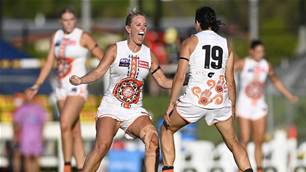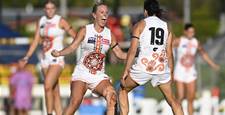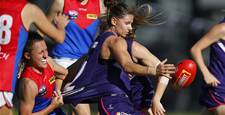The Footy Almanac have shared another extract from their latest publication in line with some of the recent commentary surrounding AFLW.
I’m not at all interested in some nasty retrospective finger-pointing exercise – in fact that would be a waste of precious energy that should now be spent developing, supporting, and promoting the women’s game, but it would be valuable at some stage to have a look at what happened and why, so that we can make sure it doesn’t happen again, elsewhere.
Perhaps, as a starting point to the conversation, someone with goodwill will put his hand up and say ‘hey I was one of the guys in authority who kept saying no, here’s why, and here’s how we could prevent that occurring in the future’.
I haven’t heard any accountability at this stage, but maybe that will come down the track. In the meantime it is very galling to hear the responsibility for that lost time (implicit in the lesser skills development) being slated back to the current AFLW players, rather than to those who were responsible for that lag and its inevitable consequences.
It's like banning a smart and enthusiastic kid from attending school for a few years (for no reason) and then blaming the kid because their writing skills are a bit underdone.
Its not the AFLW players’ fault that they haven’t being playing footy all their lives like boys do – but what’s been exhilarating to see is that rather than sitting around grumbling, they and their colleagues and support staff are working their guts out to improve their skills under immense pressure and scrutiny, and as quickly as is possible in a quasi-professional and under-resourced environment where there aren’t enough hours in the day. And they’re doing it with lots of laughter, honesty, wit, and shoulder-to-shoulder camaraderie – very laudable Australian traits that we glorify when it's men involved.
They are a great example of an amazing generation which we should be celebrating for their guts and spirit, not groaning at in hooded judgement if they don’t always land a handball cleanly.
Instead, target that ire and criticism (if you must) at those whose uninformed prejudice halted the development, evolution, and expansion of women’s footy for decades – and if we care about an equal opportunity and just society (which I’m sure we all do) let’s make an effort to get some idea of what went wrong in this instance and make sure those types of barriers, attitudes, or policies aren’t allowed to hold people back in the future – in any field of work or play, and for any sector of our community.
A hero of mine, the singer Jessye Norman, once said … “Everyone in society should have to pull themselves up by their own bootstraps – but first we have to make sure that everyone has boots”.
In other words, the role of a sound civil society is to provide all our kids with the basic public resources, pathways, and opportunities to get started in life on an equal footing, irrespective of which demographic category they may be a part of – and then they can take it from there as individuals, depending on their particular interests, ambitions, capabilities, or character.
Women’s footy is a microcosm reflecting a thousand issues and challenges happening in the world around us – the kids have something to tell us, and in the case of footy, they are saying it with their actions and their optimism. If you naysayers stop grumbling and have a listen, you might learn something extraordinary from them.
I have.
The Footy Almanac is a collective of sports fans and writers committed to the coverage of the women’s game. This book is testament to the power of community to come together to provide a detailed record of women’s football that is the only one of its kind written by fans.
The Women’s Footy Almanac 2018 is available for purchase online here footyalmanac.com.au and in selected bookstores for $30.00.
Related Articles

Updated: AFLW Round 2 preview and schedule

Socceroo star's message to kids: Don't be an AFL player

.png&h=600&w=850&c=0&s=1)











